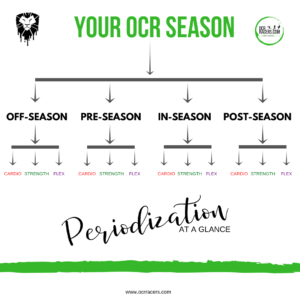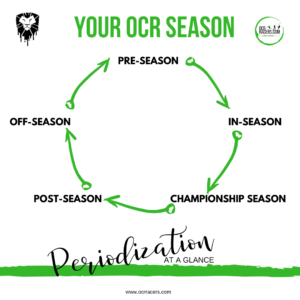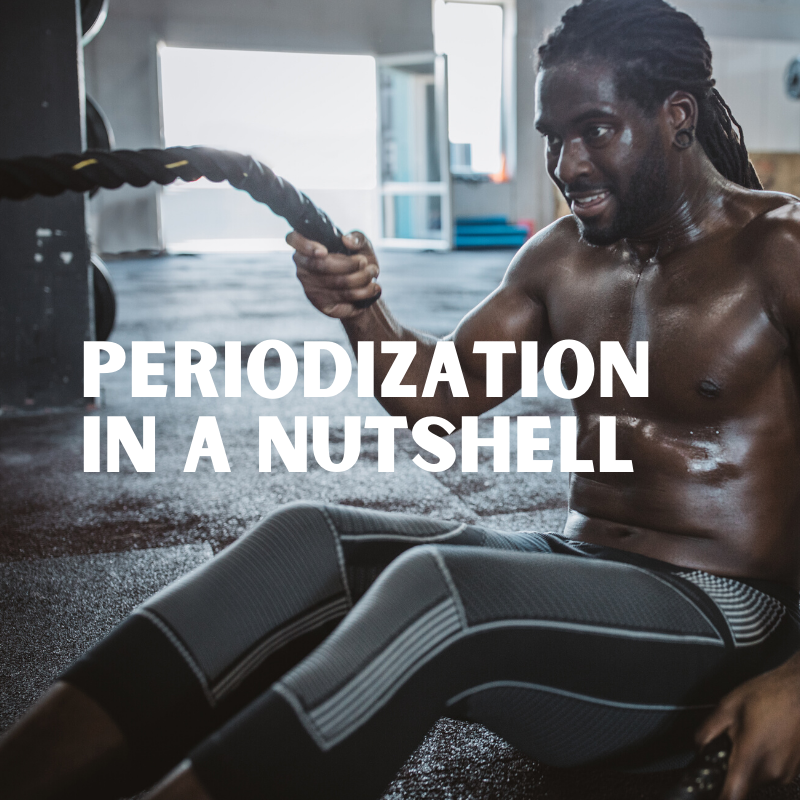We’ve previously gone into much more detail in our six-part periodization series. This article is a combined and shortened version of that series for those looking to understand the very basics. So, let’s get to it!
WHAT IS PERIODIZATION?
Periodization is dividing a time period into smaller time periods; (say for instance your entire OCR season/year.) With regard to training for OCR, take your entire OCR season and divide it into smaller segments like Off-, Pre-, In-, and Post-Season programs. Now, divvy up those seasons. The off-season will get broken down into cardio, strength, and flexibility/mobility. Do this for all seasons. Each one should have a start and a finish and break the totality of your season down into smaller segments.

GREAT…BUT WHAT DOES IT DO?
Now that you have an idea on what periodization means, you’re probably wondering how it’s utilized and how it’s beneficial. Periodization is the cheat code you never knew that your body needed in order to progress as an athlete and to improve performance.
When you divide your OCR season into smaller segments (Off/Pre/In/Post-Seasons) and then from those segments into micro-segments (cardio, flex, strength workouts), you start to unlock the key to your own potential. You are training your body with what needs to be trained at the time it needs training in order to peak and perform at your best when your A-races come around.
IS IT NECESSARY?
With no periodization program for your entire race season, it’s kind of like threading a needle with your eyes closed. You might get lucky and make it through, or you might struggle the entire way. It sounds crazy, but so is trying to make physiological improvements without a roadmap for success.
A proper periodization program can offer a different prescription for each sport/discipline. If you can familiarize your mind and body to accept this concept and also seek proper guidance and training from a knowledgable and certified professional, the real work is done before you ever pick up those weights, run those miles, or stretch those muscles.
PROGRAMS V WOD’S:
Should you follow a program or throw daily workout-of-the-days together to train? Evaluate your goals and proceed accordingly. You can follow a program but also throw in WOD’s here and there, or you can strictly adhere to a program that has your long-term goals in mind.
There’s no ultimatum to necessarily choose one or the other, but having a plan (a program) built out to match your end goals is generally a more successful path to achievement as opposed to doing whatever sounds fun for the day. Sometimes the biggest gains are made through the incorporation of “non-exciting, but necessary” exercises.
WHAT IS A WOD?
In essence, WOD’s are exactly what they sound like: a workout of the day. There’s no doubt that these serve their own purpose, are great heart-pumpers, and can be extremely beneficial for filling in a workout on days you don’t have anything scheduled, you need to change things up, or you’re traveling where things like time, equipment or space limit your ability to follow your normal program. They’re oftentimes fun and get your heart rate up quickly. These travel workouts can even be used as heart-pumping WOD’s when you lack space or equipment.
HOW IS A PROGRAM DIFFERENT?
Programming is a carefully calculated routine, generally consisting of pre-planned workouts for a duration of 6-16 weeks (depending on where you are in your training cycle), and there’s a strategic goal in mind. You want to improve as an athlete? This is where true “programs” take advantage of the known physiological adaptations and timelines.
THE MAIN DIFFERENCES:
The main differences between a WOD and a thorough Athlete Training Program is that programming uses both Minimum Effective Volume (“MEV”) and Maximum Recoverable Volume (“MRV”). WOD’s do not.
MEV is the minimum number of working sets that the body must experience in a period of time to make the desired adaptation to the stress you put your body and mind through. MRV is the maximum number of working sets that the body can experience in a period of time and still recover for optimal training without forcing overtraining.
In contrast, a WOD offers either an aerobic and/or anaerobic workout, with no thought process going into the long-term athletic aspirations. If you’re looking for athletic improvements to achieve long-term goals, then you should be considering a legitimate strength training program.

CAN YOU DO BOTH?
It’s not a bad thing to necessarily incorporate both — so long as you keep your bigger picture in mind. For example, the co-founders of ocrracers.com, Eddie and Bethany, have gone through my strength and conditioning programming for several years now. But, they have also attended a “Strongman Class” routinely to flip tires, pull sleds, or whatever else is on tap for that day. Their workout is fun, they get a great sweat on and get to work out with friends.
So, even though they do a WOD once a week — the other days are dedicated to executing their training program at full speed in order to realize long-term athletic progress. As a result, they have seen huge strides in their times, results, and overall fitness, proving to be invaluable both on and off the race course. Both have become constant contenders for podium spots each time they toe the start line.
You should be planning for your strength, flexibility and cardio to jive with one another in a strategic pattern in order to achieve optimal performance.
OCR SEASONS & PERIODIZATION:
We’ve broken down training into four OCR Seasons.
Download the handy cheat sheet of OCR Seasons here.
THE OFF-SEASON:
Let’s discuss Off-Season programs first, and what OCR periodization goals come about in the off-season.
The purpose of a true Off-Season Program is to achieve the following:
- Bodyweight goals
- Power output goals
- Performance goals
These 3 goals should be the main emphasis of an Off-Season training program. This particular program should include your physical strengths and weaknesses. It should provide an action plan you can implement.
By design, an off-season program for OCR will/should have significantly less cardio than other training seasons (but that doesn’t mean zero cardio at all!) Be ready to hit that gym, because you’ll have an increase in resistance training. Remember: the Off-Season is to build and improve muscles.
By properly implementing a planned out off-season program, your foundational building blocks will be in a really good spot for future adaptations and training blocks.
THE IN-SEASON:
At this point, all of your adjustments, gains and endurance building blocks should be set in place (via offseason and preseason programs.) A properly formatted In-Season program should be designed around Type A races; therefore, timing your body to be at peak performance for what you deem to be your most important competitions.
Since you’ve already put in the hard work before your actual race season starts, this particular program allows for making minor tweaks from lessons learned in the early part of the season, and preferably from any B & C-rated races.
—> Download the OCR Seasons cheat sheet <—
THE POST-SEASON:
The initial stages of a post-season program are meant to help your body safely taper from the strain of competition, while taking advantage of the body’s heightened state of readiness in sport-specific adaptations to enhance progress while decreasing strain on the body.
Let’s call the Post-Season program a cool-down for the OCR Season. The cool down is a more subtle, but no less important, pathway to the well-rounded performance of you– the high caliber athlete. These may not be the glamorous exercises you see on social media, but they are some of the most important.
WHAT ARE THE BENEFITS?
The biggest benefit of the post-season/cool down is blood flow. Assuming training is relatively intense, muscle fibers are torn and burning the body’s fuel creates byproduct, not all of which is performance enhancing. For example, lactic acid builds up in the muscular system leading to soreness along with what every athlete has experienced at some point: an undeniable urge to not move at all. Physically you hurt, and it mentally changes your drive to improve via continued training.
A post-season program should be shorter than the other programs. Meanwhile, the body is gradually being convinced to begin resting from the strain of an entire OCR season.
The post-season is spent preparing the body for the stresses of lifting. Additionally, other repetitive dynamic and static stability movements are used so that you don’t leave the body overly fatigued. When it’s all said and done, and you finish a proper post-season training program, you should feel recharged.
THE PRE-SEASON:
After recovering from working hard to achieve off-season gains, you need a less intense program heading into your actual OCR season. This is where the pre-season’s adaptations, combined with the work of the off-season program, maximizes those sustainable gains before allowing adequate types of rest from the types of strains brought on by an off-season program.
Look at pre-season programs as kind of a warm-up into your OCR season. On a standard scale the warmup is used to increase heart rate, body temperature, and by doing so also blood flow. Warming up can directly improve functions across all ranges of athletic performance.
Just as important as it is to warm up and cool down after every workout, it’s equally important to incorporate pre-season and post-season programming. These programs essentially connect the dots to complete the full circuit of training.

Though the in-season program is the main body of your workout, the pre-season is the warmup and post-season is the cool down. In relation to the off-season, the roles are reversed.
With this understanding, it is obvious that these programs should be organized wisely to optimize your performance when it matters most! When done correctly, the pre-season and post-season function as both warmup AND cool down.
IT’S ONE BIG, HAPPY CYCLE:
Think of your training as cyclical, serving a particular purpose.
Training should follow a purpose-driven cycle. Repetitive makes you competitive. (Speaking strictly in terms of cycles here. Your actual training programs should evolve).
Think cyclical: Pre-season, In-season, (Championships), Post-season, Off-season, Repeat.
(Championships included for illustration purposes because there’ll be championship races to work towards and potentially race in, though not necessarily to train separately for).
With continuous effort, the OCR periodization process will be incredibly beneficial to your overall training.
Periodization occurs in various stages of training; however, it also occurs within an actual season.
As athletes, when you inquire on how to plan out your training within a season, the last answer you want to hear when you’re planning out and trying to organize your training cycles within a season is: it depends. This is especially true when you’re also incorporating your periodization within a season.
If you recall, we previously wrote about rating your races from most to least important. This is exactly why it depends when periodization within a season will occur.
MANAGING TRAINING:
Once you’ve finalized and categorized your races for the race year, it is important to align your training appropriately to ensure a successful season. This could mean getting on the podium, not burning out, running as many clean races as possible, etc. That part’s up to you.
If you’re planning out your training blocks in advance, you’ll likely also be planning out your rest, taper weeks, de-load weeks, etc.
MANAGING REST:
Outside of the obvious goal of performing the best at your most important competitions, how you manage rest varies. The thing to keep in mind is that your body will respond to the situations you place it in. When it senses you’re running often, it equips itself and stays prepared for more running. As is the case with other exercises like lifting, jumping, swinging, and yes, even resting. If your body experiences consecutive days of rest, it prepares to be its best resting self.
SO…ACTIVE RECOVERY OR COMPLETE REST?
The experienced athlete knows how to give this aspect of training a day off, while others fill the void by doing something else generally classified as cross-training, not active recovery on a rest day. Just because what you did was less intense than what you normally do does not make it a rest day. Spend some time doing lower heart rate sessions with things like yoga, walking, foam-rolling or stretching.
Sometimes doing nothing IS doing something. When rest days are incorporated correctly, your body does not take it as a cue to decrease preparedness. This is actually a great trick for maintaining fitness and training capacity through an extended lengthy season.
Use this REST technique sparingly.
- 24-48 hours of decreased physical exertion allows for recovery while limiting de-conditioning.
- 72 hours and beyond without physical exertion will inevitably lead to an athlete sliding down the fitness/fatigue paradigm and possibly sacrificing some gains.
Know this: the human body has so much going on at once, it prefers not to be bogged down and prefers to keep the most readily available processing units accessible with “old” data.
WHAT KINDS OF ADAPTATIONS EXIST?
Sport and competition are hard enough– don’t make your peak performance harder to find than it really needs to be.
Outside of REST, other physical adaptations offer more guidance. Cardiovascular adaptations take less time than the musculoskeletal system. Increases in strength, power and hypertrophy should be planned months ahead. For example, your Off- and Pre-season programming need months, while (depending on the distances) cardiovascular conditioning may only need weeks. If you are an athlete that feels you need certain muscular adaptations, you will need to plan this out well ahead of time.
Each sport, each athlete, each season is different. Increasing your workload throughout a season is useful, but being fatigued from your workouts every week could negatively impact regular season competitions.
Don’t be afraid to customize your seasonal training plan if you keep these commonalities in mind. A day off might mean doing nothing, or doing something that doesn’t put you into the pain cave. Basic physiological adaptation timelines can guide you to high level performance with low level hindrances.
ROLE OF GENETICS + EPIGENETICS IN PERIODIZATION:
Genetics + Epigenetics = Secret Code!
Say what? A secret code? Yes– this is like taking the red pill. Understanding genetics + epigenetics is like truly diving deep into one’s own self to manipulate outcomes, if you will.
So, what exactly does all of this mumbo jumbo mean and what about this “secret code?”
To borrow a well-known marketing phrase…”Maybe she’s born with it, Maybe it’s Maybelline.”
Genetics = Born with it
Epigenetics = Maybelline (aka factors influencing outcome)
So, there are genetics, basically what you are born with and then you have epigenetics. With epigenetics, you can wake up or put to sleep certain components within a period of training at any given time.
Understanding epigenetics through periodization is the ultimate key to peaking and not peaking, and having certain areas of the body fire on all cylinders while the ones you worked out the other day take a rest.
An actual adaptation to periodization takes 6-8 weeks with the proper training program. It involves specific super sets and reps to allow your genetic component to adjust to proper adaptations.
Truly taking a long-term approach to the planning of one’s season and providing the greater adaptation windows can only benefit an athlete. However, taking the added bonus of potential epigenetic influences into account gives you all the tools to elevate your performances.
HOW DOES IT WORK AS AN ATHLETE?
Once all of this is put together, an athlete should see a relation to proper planning, or planning by the seat of your pants. Some fitness professionals will do this for you, some may not. It’s absolutely always something I consider in establishing programming for athletes.
SO STRUCTURE IS GOOD?
There is a reason some of your top-tier athletes could be looked at as having extremely rigid plans. Where the way to look at it is this: structure in your life is necessary to compete at the highest level you desire. Once an athlete makes this kind of commitment, everything matters!! Hence the true benefit of epigenetics: the added bonus in your genetic code. Your third eye…. Knowing your body.
Knowing proper nutrition that works for you, your personal necessary amount of sleep, how to deal with stress, work, providing for your loved ones. Everything, I mean everything, plays a role in you being able to display your best performance.
RELY ON EXPERTS:
Take notes, hire professionals, talk with other athletes and their experiences, do research. Do what you have time for, but lean on professionals for the rest. In my heart, this is what I am meant to do: share my passion and knowledge with you and help you become the best version of your fit self.
Periodization
Allows
Life’s
More
Exceptional
Results
For a deeper dive, check out any or all of our longer articles on periodization.
- Part 1 – Periodization: What is it, And Why Does it Matter?
- Part 2 – Periodization: Programming vs WOD’s
- Part 3 – Periodization: Off-season and In-Season Programs
- Part 4 – Periodization: Pre-Season and Post-Season Programs
- Part 5 – Periodization: Within A Season
- Part 6 – Periodization: Genetics + Epigenetics = Secret Code!
About the Author:
Palmer Shape holds a B.S. in Physiology and is a Certified Strength and Conditioning Specialist designation (CSCS). Palmer Shape is equipped with over a decade of competition experience, having coached and trained hundreds of high school, college, and professional athletes, including obstacle course racers. A hurdler by nature, he is no stranger to overcoming obstacles quickly and efficiently. His passion, combined with scientific knowledge and data, have helped hundreds of athletes take their training to the next level, often reaching podium spots or winning coveted titles.


